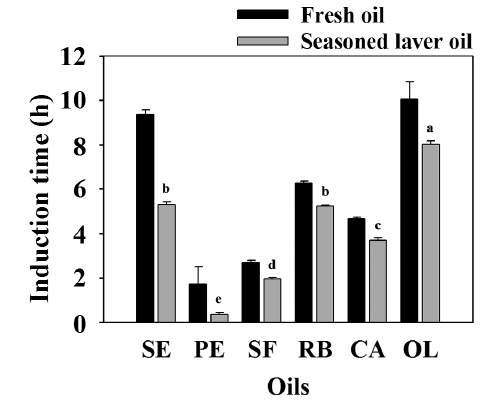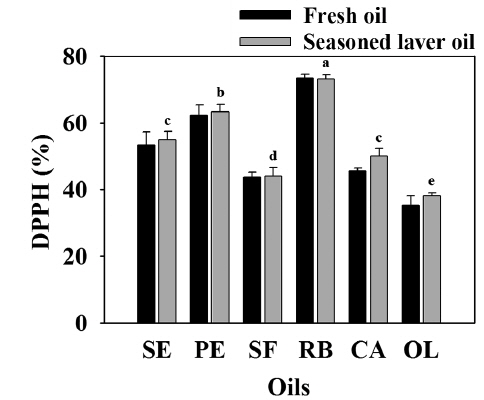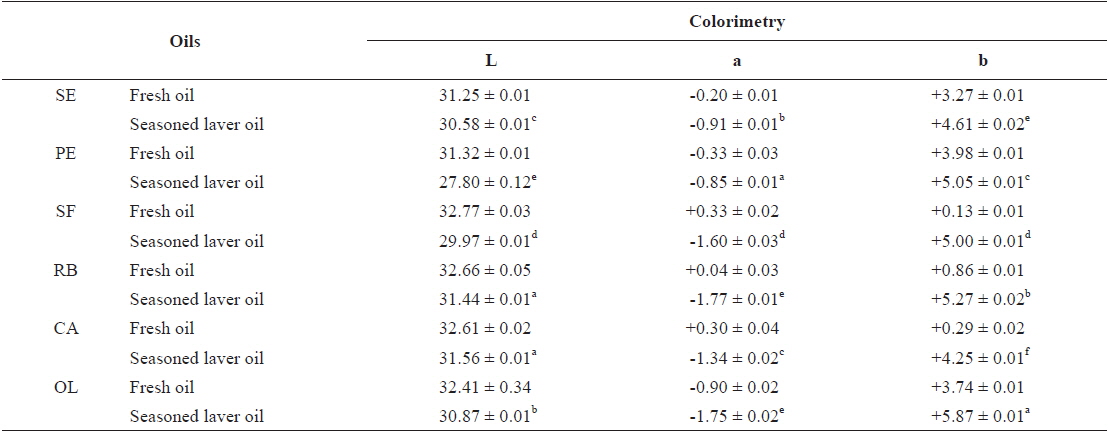



Seasoned laver
Vegetable oils are the most important ingredient (30–40%, w/w) in the preparation of seasoned laver products (Lee, 1999; Jo et al., 1995). In commercial seasoned laver products, sesame and perilla oils are most frequently used. During the seasoned laver processing, UHT treatment at 300℃ induces thermal oxidation of the vegetable oils (Jo et al., 1995). Owing to the high oil content and UHT treatment, the oxidative stability of the oil is the most important factor in determining the shelf life of seasoned laver products (Wang et al., 2010; Hasenhuettl and Wan, 1992).
The general shelf life of seasoned laver supplied in domestic grocery-retail is about 6–12 months (Lee, 1999; Cho et al., 2009). This short shelf life is becoming a major problem in establishing export of the seasoned laver. Therefore, studies on prolongation of the shelf life of seasoned laver based on inhibition of oil oxidation are a promising research field in the Korean seaweed industry. Although various vegetable oils, such as sesame and perilla oils, are used in the seasoned laver preparation, there are few studies on their thermal oxidation stability.
In the present study, we investigated changes in the thermal oxidative properties of six major vegetable oils (sesame, perilla, sunflower, rice bran, canola, and olive) during the seasoned laver processing. The oxidative stability of each oil was evaluated by determination of the oxidation induction time using a Rancimat instrument. Moreover, the acid value, peroxide value,
Sunflower (SF), rice bran (RB), canola (CA), and olive (OL) oils were purchased from CJ Cheiljedang Co., Ltd. (Seoul, Korea). Sesame (SE) and perilla (PE) oils were purchased from Chamgoeul Co., Ltd. (Seoul, Korea). These oils were stored in a refrigerator until use in an experiment. Sheet-type dried laver (
For preparation of the seasoned laver, a sheet of dried laver (2.5 g) was heated at 300℃ for 10 s after applying oils (1.6 g). The seasoned laver oils were then isolated using a press machine.
>
Oxidative stability using a Rancimat method
The oxidative stability of the fresh and seasoned laver oil samples were evaluated by measuring the oxidation induction time using a Rancimat instrument (Metrohm CH series 743, MetrohmAG, Herisau, Switzerland). The oxidation process was monitored for a 3 g sample of oil using an air velocity of 20 L/h at 120℃. During the Rancimat test, volatile compounds, such as formic acid, were rapidly produced and carried by the steam of air to be collected in deionized water. The vapors were continually monitored by measuring the conductivity of the deionized water. The end point was determined in hours.
>
Measurement of acid and peroxide values
To evaluate the stability of oils against thermal oxidation, the acid values (AVs) of the oils were determined utilizing an AOCS official method (AOCS, 1990). In brief, 10 g of each oil was weighed into a 125 mL-flask and mixed with 100 mL of a diethyl ether:ethanol (1:1, v/v) solution with a couple of drops of 1% phenolphthalein in ethanol (v/v) for indicator. This solution was titrated with 0.1 N potassium hydroxide solution.
The peroxide values (POVs) were determined using an AOCS official method. In brief, 5 g of each sample was weighed into a 125 mL-flask and mixed with 35 mL of chloroform:acetic acid (2:3, v/v) and 1 mL of saturated potassium iodide solution and mixture was shaken vigorously for 2 min and stored under dark conditions for 10 min. Subsequently, 75 mL of distilled water was added to the mixture, which was then shaken again. For the titration, 1 mL of 5% starch solution as an indicator was added to the mixture, which was then titrated with 0.01 N sodium thiosulfate solution.
>
p-Anisidine value and total polar compounds
The
p-AV = 25 × (1.2 × A2 – A1)/W
where A1 is the absorbance at 350 nm before addition of
The total polar compounds (TPCs) in each oil sample were determined by a Testo 270 cooking oil tester (Testo Ltd., Hampshire, UK) according to the manufacturer’s operation guide. Each sample was maintained at 60℃ for the measurement. The cooking oil tester provided the TPCs values by measuring changes in the dielectric constant of the oil samples, which is highly correlated with the amount of polar compounds in the sample. Each sample was assayed in triplicate.
The antioxidant capacity of each oil was determined by a method of Blois (1958) compared using a modified 2,2-diphenyl-1-picrylhydrazyl (DPPH) method. A portion of each oil (56 μL) was mixed with 5 mL of 0.10 mM DPPH in isooctane in a 50 mL tube and stored under dark conditions for 30 min. After standing, the absorbance of the each sample was measured at 517 nm using a UV-Vis spectrophotometer (Cary 50, Varian, Palo Alto, CA, USA). The free radical scavenging activity measured by the DPPH method was considered as the antioxidant capacity of each oil.
The color levels of oils were determined using a colorimeter (CR-300, Minolta, Japan). Approximately 2 g of oil was transferred to a petri dish (diameter: 3.5 cm) and measured the Hunter color scale which L (lightness), a (redness), and b (yellowness). For the reference color white board were used and its color scales were L=93.79, a=-0.12, and b=-0.20, respectively.
The differences of experimental parameter in the samples were analyzed statistically using ANOVA and Tukey’s multiple range test at
The thermal oxidative stabilities of six vegetable oils from seasoned laver products were evaluated using the Rancimat method. This is the most common test used to assess the oxidative stability of edible oils, which is expressed as the oxidation induction time (Farhoosh and Kafrani, 2011). The oxidation induction times of all the oils from the seasoned laver products were significantly decreased compared with the fresh oils (Fig. 1). These results mean that the UHT treatment used in the seasoned laver processing induces oxidation of the oils despite the short treatment time. Among the six seasoned laver oils, OL showed the highest thermal oxidative stability (induction time: 8.02 h). In previous studies (Chiou et al., 2009; Casal, 2010), OL is well known to have excellent oxidative stability. OL contains more monounsaturated (palmitic and oleic) acids than other vegetable oils and less polyunsaturated acids, such as linolenic acid, that is, OL is more stable than other vegetable oils and not easily broken down by thermal oxidation (Velasco and Dobarganes, 2002; Chiou et al., 2009). Moreover, there are a variety of polyphenols with antioxidant activity in OL that contribute to the oxidative stability (Psomiadou and Tsimidou, 2002; Leonardis et al., 2013).
SE and PE oils are most frequently used for seasoned laver preparation owing to their excellent sensory properties. SE had the second most stable oxidation stability of the studied oils (oxidation induction time of 5.31 h) because SE contains natural antioxidants such as sesamin, sesamol, and sesamolin and is rich in tocopherols (Lee et al., 2008). In addition, SE has a high content of monounsaturated (oleic and linoleic) acids, which inhibit thermal oxidation (Bayder et al., 1999; Uzun et al., 2002). On the other hand, the induction time of PE (1.73 ± 0.77 h) showed the lowest oxidation stability among the tested oils, and the greatest decrease (79.7%) compared with the fresh oil. This result indicates that PE contains a high content (59%) of oxidation-susceptible linolenic acid (Wang, 2010; Zhao, 2012), which can induce rapid oxidation during UHT treatment.
AV and POV are important indexes of food quality for seasoned laver products. According to the Ministry of Food and Drug Safety (2011), the standard values of AV and POV in seasoned laver products are 4.0 mg KOH/g and 60.0 meq/kg, respectively. The AV indicates the level of free fatty acids in oils. Oils are oxidized by the action of oxygen or microorganisms during storage and the amount of free fatty acids are an indicator of the degree of oxidation (Kim et al., 2010). The AVs of the six vegetable oils are presented in Table 1. The AVs of OL, SE, RB, CA, SF, and PE oils from the seasoned laver products were 0.49, 0.79, 0.59, 0.11, 0.14, and 2.82 mg KOH/g, respectively. The AV of PE was significantly higher than those of the other oils, whereas CA had the lowest AV level (
[Table 1.] Acid value (AV) and peroxide value (POV) of fresh and seasoned laver Pyropia spp. oils
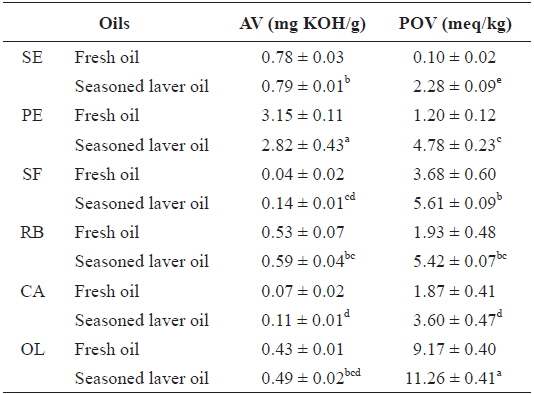
Acid value (AV) and peroxide value (POV) of fresh and seasoned laver Pyropia spp. oils
The POV is determined using the peroxide content that is produced from oxidation of the oils (Kim et al., 2010). The POVs of the six vegetables oils are shown in Table 1. The POVs of OL, SE, RB, CA, SF, and PE oils from the seasoned laver products were 11.26, 2.28, 5.42, 3.60, 5.61, and 4.78 meq/kg, respectively. The POV of OL was significantly higher than those of the other oils (
The
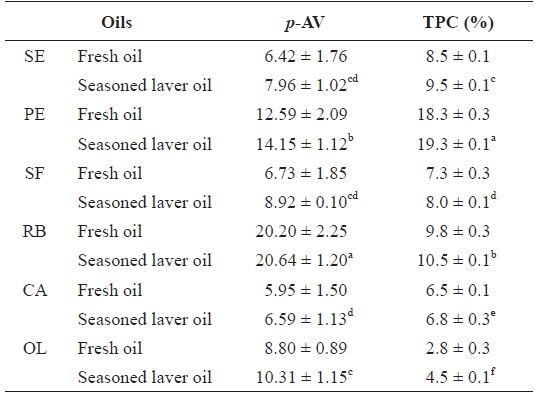
p-Anisidine value (p-AV) and total polar compounds (TPC) of fresh and seasoned laver Pyropia spp. oils
The DPPH assay determines the free radical scavenging capacity as a measure of the antioxidant capacity in samples. DPPH has a stable radical with a maximum absorbance at 517 nm, and the absorbance is decreased by the addition of an electron or hydrogen radical. The antioxidant capacities of the vegetable oils are shown in Fig 2. The free radical scavenging capacities of the seasoned SE, PE, SF, BR, CA, and OL were 54.88 ± 2.46, 63.26 ± 2.23, 43.96 ± 2.59, 73.08 ± 1.35, 50.01 ± 2.31, and 38.17 ± 0.81%, respectively. BR showed the highest antioxidant capacity, whereas OL had the lowest (
The color of an oil is one of the most important physical indicators for the determination of oil quality. The color scales of the vegetable oils were measured by a colorimeter and are shown in Table 3. The L- (lightness) values of the oils ranged from 27.80 ± 0.12 in PE to 31.56 ± 0.01 in CA; RB and CA showed significantly higher L-values (
[Table 3.] Colorimetry of fresh and seasoned laver Pyropia spp. oils

Colorimetry of fresh and seasoned laver Pyropia spp. oils
In summary, OL and SE oils showed excellent oxidative stability under UHT conditions in terms of oxidation induction time, and their AV and POV were lower than the standard values of the Ministry of Food and Drug Safety. The oil used in the production of commercial seasoned laver products is a mixture of two or three vegetable oils. Therefore, studies on the influence of the formulation ratio of the oil mixture are needed in the future. Our other study (Cho et al., 2015), which deal the effects of the blending ratio of corn, sesame, and perilla oils on the oxidation and sensory quality of seasoned laver, may be good information.
